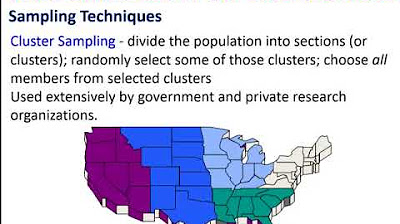Controlled Experiments: Crash Course Statistics #9
TLDRThe video discusses experimentation methods researchers use to answer questions and test hypotheses. It explains how simulations, experiments with control groups, placebos, blind studies, matched pairs, and natural experiments allow researchers to mimic parallel universes to isolate treatment effects. These techniques help account for biases and establish causation. The video advocates informed skepticism of research claims by considering the experimental methods used to generate the conclusions.
Takeaways
- 😀 Experiments try to mimic parallel universes by splitting groups randomly to reduce bias
- 😯 Researchers use simulations to study things like cancer treatments and climate change
- 🤔 Random assignment of subjects to groups helps reduce systematic differences between groups
- 😮 Treatments are conditions researchers want to test, like medicines or interventions
- 🧐 Controls allow researchers to see changes just due to time or circumstance
- 🤨 Placebos help control for placebo effects from just taking part in research
- 😎 Blinding subjects and double blinding helps reduce researcher bias
- 😃 Matched-pairs experiments use very similar subjects to try to mimic parallel universes
- 🤓 Repeated measures give the same subject different treatments one at a time
- 💡 Natural experiments utilize policy changes to study impacts, like Philadelphia's soda tax
Q & A
What is the main premise behind Elon Musk's simulation theory?
-Elon Musk argues that in the future, we will be able to create extremely realistic simulations that are indistinguishable from real life. He proposes that there is a high probability that we are currently living in such a simulation.
How can simulations help researchers test ideas?
-Simulations allow researchers to test ideas, like new drugs or disaster response plans, by creating a virtual environment where different scenarios can play out. This is safer, faster, and cheaper than trying things in the real world.
How do experiments attempt to mimic parallel universes?
-Experiments split the available subjects randomly into groups to compare different treatments. The random assignment makes the groups equal at the start, similar to parallel universes.
What is the purpose of control groups in experiments?
-Control groups receive no treatment or a placebo. This allows researchers to account for changes over time and compare to the group(s) receiving the actual treatment, isolating the treatment's effects.
What are some examples of placebo effects?
-Just participating in an experiment or taking a fake pill can make people feel better. These placebo effects need to be controlled for to know if a real treatment works.
What is a double-blind study and why is it considered the gold standard?
-In a double-blind study, neither the subjects nor the researchers know who is receiving which treatment. This removes possible biases and is considered the best type of experiment.
How are matched-pairs experiments different from random assignment?
-In matched-pairs, similar subjects are paired up and one receives Treatment A while the other receives Treatment B. This further reduces pre-existing differences.
What is an example of a natural experiment opportunity?
-When Philadelphia implemented a soda tax on some stores but not others based on location, it created a natural experiment to study the tax's effects.
Why is it important to understand how experiments work?
-Knowing how researchers test things like medicines allows us to be better informed consumers and evaluate claims critically.
What questions should you ask about medical studies or homeopathic treatments?
-You should ask questions like: How was this tested? Who did the testing? What was the control or comparison group?
Outlines
🎥 Introducing simulations and experiments
This paragraph introduces the concept of simulations, referring to billionaire Elon Musk's claim that we likely live in a simulation. It explains how simulations could be used to test things and draw conclusions in hypothetical parallel universes. The paragraph then states that since we can't yet run parallel universes, researchers rely on experiments and random assignment to create treatment and control groups that mimic parallel universes.
😎 Using controls and placebos in experiments
This paragraph explains the role of control groups in experiments to account for changes over time and compare against the treatment group. It introduces placebo effects and explains how placebos allow controlling for other factors by pretending to treat both groups. The paragraph recommends using placebos and controls that resemble the actual treatment to isolate the effect of interest.
📊 Other experimental designs
This last paragraph covers additional experimental designs like matched-pairs studies using similar subjects, repeated measures using the same subjects with different treatments, and natural experiments that arise fortuitously like Philadelphia's soda tax. It concludes by stating that knowing experiment methodology allows being a more informed consumer of research.
Mindmap
Keywords
💡Simulation
💡Experiment
💡Random Assignment
💡Treatment
💡Control
💡Placebo
💡Blinding
💡Matched Pairs
💡Repeated Measures
💡Natural Experiment
Highlights
Elon Musk argues we may be living in a simulation that is indistinguishable from real life.
Simulations allow testing things like new cancer treatments without needing parallel universes.
Experiments randomly split groups to mimic parallel universes and reduce bias.
Random assignment makes groups equal before treatments and prevents selection bias.
Treatments are conditions tested like medicines or interventions.
Control groups account for changes over time without treatments.
Placebos control for placebo effects from just participating.
Blinding prevents bias from subjects and researchers knowing treatments.
Double blind studies use placebos to blind both subjects and researchers.
Matched pairs studies use very similar subjects for better comparisons.
Repeated measures give multiple treatments to same subjects.
Natural experiments use policy changes to mimic controlled tests.
Experiments inform decisions on products and policies.
Knowing experiment methods allows informed evaluation of claims.
Ask how and who when evaluating claims based on experiments.
Transcripts
Browse More Related Video

Elementary Statistics - Chapter 1 Introduction to Statistics Part 2

Experimental Design - Research Methods [A-Level Psychology]

Psychological Research: Crash Course Psychology #2

Introduction to Experimental Designs; Principles; Randomization; Replication; Local Control

Sampling Methods and Bias with Surveys: Crash Course Statistics #10

2^k Factorial Designs Experiment - ANOVA Model
5.0 / 5 (0 votes)
Thanks for rating: